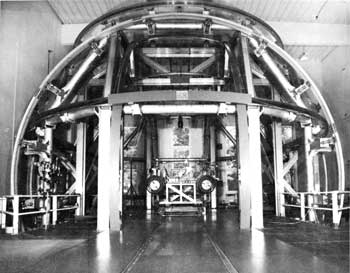.gif)
|
Man in Space
A National Historic Landmark Theme Study |

|
|
Unmanned Spacecraft Test Facilities |

Interior view of Spacecraft Magnetic Test Facility
showing Lunar Rover Vehicle Test, 1971.
(Courtesy of NASA, NASA/Goddard Space Flight Center Facilities Office)
Spacecraft Magnetic Test Facility
| Name: | Spacecraft Magnetic Test Facility (Attitude Control Test Facility) |
| Location: | Goddard Space Flight Center, Greenbelt, Maryland |
| Owner: | National Aeronautics and Space Administration (NASA) |
| Condition: | Excellent, unaltered, original site |
| Builder/Architect: | NASA |
| Dates: | 1966-Present |
DESCRIPTION
The Spacecraft Magnetic Test Facility was built in 1966 and consists of a 60-foot square building constructed of nonmagnetic materials, which contains a 42-foot-diameter coil system. The coil, a 3-axis Braunbek system of 4 loops on each axis, provides cancellation of the earth's magnetic field over the central 6-foot-diameter spherical volume, uniform to 0.001% and stable to a half nanotesla. Geomagnetic fluctuations up to 16 Hz and ± 750 nanoteslas are eliminated by automatic servo-control from 3 remotely-located rubidium magnetometers. The coil can generate a stable artificial field from zero to 60,000 nanoteslas in steps of 0.1 nanotesla. The artificial magnetic vector can be rotated about any axis at rates of zero to 100 tad/sec.
Accessories include nonmagnetic tracks and dollies to transport the test item in and out of the coil system, and an 8 foot-diameter powered turntable at the coil center for positioning the test item, 9 foot-5 inch Helmholtz coils to provide dc and ac field exposure up to 50 x 10-4 tesla for perm and deperm treatment, and a sensitive nonmagnetic torquemeter capable of measuring magnetic torques of 10 x 10-7Nm on test items weighing up to 4000 kg.
The coil building is about 2 miles east of the Goddard Space Flight Center. Access is through a truck lock with doors 14 feet by 15 feet high. Material handling is accomplished with a 3-ton monorail hoist in the truck lock and 5000-pound-capacity fixed location hoists on the coil center line and outside the coil. The coil has a 10 foot-3 inch square opening and a clear interior work space 25 feet in diameter x 17 feet-6 inches high. The coil building is air-conditioned to maintain the dew point at 50°F or less. Cleanliness is maintained by passing all air introduced into the building through a bank of HEPA (high-efficiency particulate air) filters. A recirculating air system to maintain a higher degree of contamination control in the work space is available. [1]
STATEMENT OF SIGNIFICANCE
The Spacecraft Magnetic Test facility is the only facility in NASA's inventory that makes it possible to determine and to minimize the magnetic movement of even the largest unmanned spacecraft and observatories and thereby reduce unwanted torques due to the interaction of magnetic movement with magnetic vector. The limited evaluation of magnetic control systems is also possible as is the final calibration of precision flight magnetometers in orbital configuration. [2]
Without the use of the Spacecraft Magnetic Test facility and information it provides in the testing of large satellites, the United States would be unable to successfully orbit and maintain the large variety of satellites that have provided information on weather, communications, earth resources and many other fields. The use and operation of this facility is essential to the continuing success of the American Manned and Unmanned Space program. The Spacecraft Magnetic Test facility is unique and is not replicated anywhere else in the United States.
FOOTNOTES
1. Technical Facilities Catalog Vol. I (Washington, D.C.: National Aeronautics. and Space Administration, October, 1974), P. 5-15.
2. Technical Facilities Catalog Vol. I (Washington, D.C.: National Aeronautics and Space Administration, March, 1967), pp. 7-16, 7-17.
BIBLIOGRAPHY
Boyle, J.C. Lunar Roving Vehicle Magnetic Test X-325-72. Greenbelt, Maryland: Goddard Space Flight Center, October 1971.
Technical Facilities Catalog Vol. I. Washington, D.C.: National Aeronautics and Space Administration, March 1967.
Technical Facilities Catalog Vol. I. Washington, D.C.: National Aeronautics and Space Administration, October 1974.
PHOTOGRAPHS
(click on the above photographs for a more detailed view)
Last Modified: Mon, Jan 8 2001 10:00:00 am PDT
man-in-space/space19.htm



 Top
Top